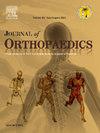Comparison of patient outcomes of anterior and posterior lumbar interbody fusions: A retrospective national database analysis
IF 1.5
Q3 ORTHOPEDICS
引用次数: 0
Abstract
Background
Lumbar interbody fusions are used to treat degenerative lumbar disease unresponsive to conservative treatment. This procedure may be divided into anterior lumbar interbody fusion (ALIF), and posterior lumbar interbody fusion (PLIF/TLIF). Despite their widespread use, comparative research on their outcomes remains limited.
Methods
The PearlDiver Database was utilized to identify patients undergoing single and multi-level ALIF and PLIF/TLIF between 2010 and 2022. We examined demographic data, comorbidities, and reoperation rates at 90 days, 1 year, and 2 years. Complications were assessed using multivariable regression to adjust for confounders.
Results
The study included multi-level anterior interbody fusions (N = 569, mean age 59.8, 59 % female), multi-level posterior interbody fusions (N = 43,651, mean age 57.9, 60 % female), single-level anterior interbody fusions (N = 3,547, mean age 55.3, 61 % female) and single-level posterior interbody fusions (N = 25,792, mean age 56.9, 62 % female). Multi-level posterior interbody fusion patients had a lower prevalence of HTN (OR .77, P < .05), ischemic heart disease (OR .73, P < .05), CDK (OR .77, P < .05), postoperatively more DVTs (OR 1.44, P < .05), a lower incidence of respiratory failure (OR .57, P < .05), and a higher 90-day, 1-year, and 2-year all-cause reoperation rate (7.3 %) compared to multi-level anterior interbody fusion patients (3.7 %). Single-level posterior interbody fusion patients had more HTN (OR 1.1, P < .05), less ischemic heart disease (OR .89, P < .05), obesity (OR .92, P < .05), and postoperatively a higher incidence of DVT (OR 1.34, P < .05) but lower 90-day, 1-year, and 2-year all-cause reoperation rates.
Conclusions
This study confirms that posterior interbody fusions are more common than anterior procedures, though the latter is increasing. Reoperation rates are higher for multi-level posterior and single-level anterior fusions. Both anterior and posterior approaches show similar complication profiles, though specific risks, such as postoperative DVT, vary. These findings emphasize the need for ongoing research and consideration of individual patient factors when choosing an interbody fusion technique.
前路和后路腰椎椎间融合术患者疗效的比较:回顾性国家数据库分析
背景腰椎椎间融合术用于治疗对保守治疗无效的退行性腰椎疾病。这种手术可分为前路腰椎椎间融合术(ALIF)和后路腰椎椎间融合术(PLIF/TLIF)。方法 我们利用PearlDiver数据库来识别2010年至2022年间接受单层和多层ALIF和PLIF/TLIF手术的患者。我们研究了人口统计学数据、合并症以及90天、1年和2年的再手术率。研究包括多层次前路椎体间融合术(N = 569,平均年龄 59.8 岁,59% 为女性)、多层次后路椎体间融合术(N = 43 651,平均年龄 57.9,女性占 60%)、单层前路椎体间融合术(N = 3,547 例,平均年龄 55.3 岁,女性占 61%)和单层后路椎体间融合术(N = 25,792 例,平均年龄 56.9 岁,女性占 62%)。多层次后椎间融合术患者的高血压(OR .77,P < .05)、缺血性心脏病(OR .73,P < .05)、CDK(OR .77,P < .05)、术后深静脉血栓(OR 1.44,P < .05),呼吸衰竭发生率较低(OR .57,P < .05),90 天、1 年和 2 年全因再手术率(7.3%)高于多层次前路椎体间融合术患者(3.7%)。单层后椎间融合术患者有更多的高血压(OR 1.1,P < .05)、更少的缺血性心脏病(OR .89,P < .05)、肥胖(OR .92,P < .05),术后深静脉血栓的发生率更高(OR 1.结论这项研究证实,后路椎体间融合术比前路手术更常见,尽管后者正在增加。多层次后路和单层次前路融合术的再手术率更高。前路和后路方法的并发症情况相似,但术后深静脉血栓等特定风险有所不同。这些研究结果表明,在选择椎间融合技术时,需要不断进行研究并考虑患者的个体因素。
本文章由计算机程序翻译,如有差异,请以英文原文为准。
求助全文
约1分钟内获得全文
求助全文
来源期刊

Journal of orthopaedics
ORTHOPEDICS-
CiteScore
3.50
自引率
6.70%
发文量
202
审稿时长
56 days
期刊介绍:
Journal of Orthopaedics aims to be a leading journal in orthopaedics and contribute towards the improvement of quality of orthopedic health care. The journal publishes original research work and review articles related to different aspects of orthopaedics including Arthroplasty, Arthroscopy, Sports Medicine, Trauma, Spine and Spinal deformities, Pediatric orthopaedics, limb reconstruction procedures, hand surgery, and orthopaedic oncology. It also publishes articles on continuing education, health-related information, case reports and letters to the editor. It is requested to note that the journal has an international readership and all submissions should be aimed at specifying something about the setting in which the work was conducted. Authors must also provide any specific reasons for the research and also provide an elaborate description of the results.
 求助内容:
求助内容: 应助结果提醒方式:
应助结果提醒方式:


